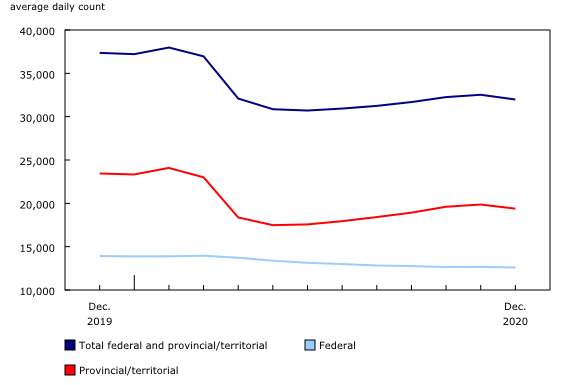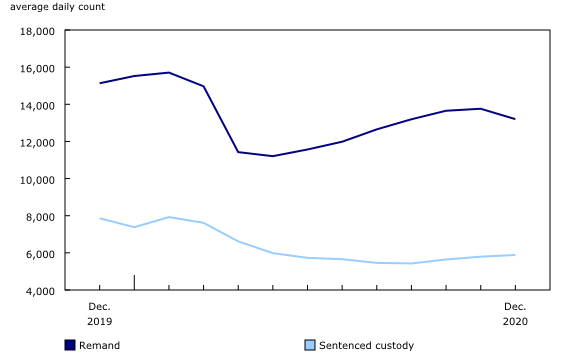After an unprecedented decline early in the pandemic, the number of adults in custody rose steadily over the summer and fell again in December 2020
Archived Content
Information identified as archived is provided for reference, research or recordkeeping purposes. It is not subject to the Government of Canada Web Standards and has not been altered or updated since it was archived. Please "contact us" to request a format other than those available.
Released: 2021-07-08
The average number of adults in federal, provincial and territorial custody on any given day in 2020 fluctuated in tandem with the pandemic. During the early months of the pandemic, there was a record 15% decline in the number of adults in Canadian correctional institutions, falling from 37,976 in February to 32,091 in April 2020. Historically, monthly changes in counts of adults in custody rarely exceed 1%.
In May and June 2020, the decline slowed, and from July to November, the average daily count of adults in custody edged up every month. In December, at the beginning of the second wave of the pandemic, the average daily count of adults in custody declined 2% to 31,981.
The Canadian courts and correctional systems have taken steps to reduce the size of the correctional institution population during the COVID-19 pandemic, while balancing public safety concerns. Measures include the temporary or early release of persons in custody who are considered low risk to reoffend; extended periods for parole appeal deadlines and access to medical leave privileges; and alternatives to custody while awaiting trial, sentencing and bail hearings.
The pandemic has presented many health and safety challenges for Canadians. Correctional institutions are particularly at risk of COVID-19 outbreaks due to the close proximity of their population, lack of physical distancing, the movement of individuals in and out of facilities and the challenge of meeting heightened cleaning and hygiene requirements.
Publicly available data from Correctional Service Canada (CSC) show that 1,580 inmates at federal correctional institutions across Canada had tested positive for COVID-19 as of June 29, 2021. The vast majority (99%) of federal inmates who tested positive have recovered, while six inmates died of COVID-19. At the time of data collection, there were no active cases in federal correctional facilities.
While the data in this release quantify the magnitude of change, they cannot show the extent to which special safety measures implemented during the pandemic, such as temporary and/or early release or alternatives to custody, contributed to lower custody counts.
Federal custodial population continues to trend downward from October to December
In Canada, the administration of correctional services is a shared responsibility between the federal, provincial and territorial governments.
Correctional Service Canada is responsible for the federal system and has jurisdiction over adults (18 years and older) serving custodial sentences of two years or more, including all those serving indeterminate prison sentences and dangerous offenders.
The average daily count of adults in federal custody declined steadily from March to October 2020, falling from 13,957 in March to 12,652 in October—an overall decrease of 9%. Following little change in November, the number of federally incarcerated adults decreased 1% in December to 12,592. For more information on counting differences between federal, provincial and territorial correctional systems, please see the note to readers.
Provincial and territorial adult custodial population rises every month from June to November, declines in December
Provincial and territorial correctional service programs are responsible for adults serving custodial sentences that are less than two years (including those on intermittent sentences, to be served typically on weekends, with intermittent releases to the community on weekdays), as well as those who have been remanded in custody (individuals awaiting trial or sentencing).
While the pandemic brought unprecedented changes in both the federal and provincial/territorial populations, the changes at the provincial and territorial level were more pronounced. After a record decline in the number of adults in provincial and territorial custody (including those in remand awaiting trial or sentencing, and those in sentenced custody) when the average daily count dropped from 24,085 in February to 17,483 in May 2020 (-27%), counts stabilized in June, then increased every month from July to November. In December, the number of adults in provincial and territorial custody decreased 2% to 19,389.
In December, the average daily count of adults in provincial and territorial custody was still below pre-pandemic levels (i.e. the average daily count in February 2020) in every jurisdiction except Newfoundland and Labrador, Prince Edward Island and Nunavut.
Provincial and territorial remand population declines in December while the sentenced custody population increases
Trends in the adult provincial and territorial custodial population from February to December 2020 were largely driven by changes in the remand population, meaning those in custody awaiting trial or sentencing.
After falling by one-quarter (-25%) from March to May 2020, the number of adults in remand increased 3% in June, and continued to rise every month from July to November, reaching 13,759. However, in December, the number of adults in remand decreased 4% to 13,201.
In every province and territory except Ontario and Alberta, the remand population decreased from October to December. In fact, in December, the number of adults in remand remained below pre-pandemic levels in every jurisdiction except Prince Edward Island and Nunavut.
Changes in the number of adults in sentenced custody followed a different trend. After declining every month from March to September, the number of adults in sentenced custody increased from October to December (+4%) to 5,885.
The sentenced custody population increased in all but three jurisdictions from October to December— Saskatchewan, Yukon, and Nunavut. By December, the number of adults in sentenced custody remained below pre-pandemic levels in every province and territory except Newfoundland and Labrador and Yukon.
The number of adult women in provincial and territorial custody has grown at a faster pace compared with men since June
The unprecedented decline in the provincial and territorial adult custodial population was more pronounced for women than men during the early stages of the pandemic. The average daily count of women in provincial and territorial custody declined by over two-fifths (-42%), falling from 2,147 in February to 1,243 in May 2020. In comparison, the number of men in provincial and territorial custody fell by one-quarter (-26%) over the same period, declining from 21,938 to 16,240.
However, the average daily count of adults in provincial and territorial custody edged up in June, and continued to increase into the summer and fall of 2020 for both men and women. The number of women (+21%) in provincial and territorial custody grew at a faster pace than men (+10%) from June to December.
Despite recent increases, the number of men and women in provincial and territorial custody remained substantially lower than pre-pandemic levels ten months into the pandemic. In December, the number of men in provincial and territorial custody was 19% lower than the number in February 2020, while the number of women in provincial and territorial custody was 29% lower.
Note to readers
Since the beginning of the pandemic, correctional programs have implemented measures to maintain safe and secure environments and to ensure the continued health, safety and well-being of employees, persons in custody and in-person visitors. Some protective measures implemented by correctional institutions to reduce COVID-19 transmission include providing personal protective equipment to staff; increased access to hygiene and cleaning supplies for persons in custody and correctional staff; and increased physical health screening at intake.
Other measures include the suspension of inter-regional and international transfers of persons in custody as well as in-person visitors to correctional facilities. There has been greater use of technology to support video visitation with family and in some cases court appearances.
Furthermore, protocols have been implemented for the assessment, testing and seclusion of persons in custody suspected or confirmed to have a communicable disease.
Data on the number of active COVID-19 cases in Canada are publicly available on the Government of Canada website. Correctional service programs are continuing to manage custodial institutions during the pandemic and Statistics Canada will continue to provide data on custodial populations on a regular basis.
Data Source
Statistics Canada's Adult Key Indicators Report (KIR) collects data from all adult correctional service programs in Canada that provide an average daily count of persons in federal and provincial and territorial custody, for each month of the year. To do this, correctional services generally take a count of persons in custody every day and it is averaged over the number of days in that month.
At the federal level, the monthly numbers represent the counts at the mid-point of each month as reported by Correctional Service Canada (CSC) and include persons in custody on temporary absence. Given that the federal March counts were taken mid-month, they do not reflect the full impact of COVID-19, as measures to address the pandemic began to be implemented in the second half of the month.
Data on the sex of the federal custodial population are not collected as part of the KIR administered to CSC and are therefore not included.
Data on Indigenous identity and visible minority group of adults in custody are not collected as part of the KIR and are therefore not available for this analysis.
Reporting changes were made by Yukon as of October 2020. Previously, other/temporary detention counts were included in remand counts; however, they are now reported separately.
Data from April to September 2020 for Quebec were revised, therefore figures for the total adult custodial population, as well as total provincial and territorial custody figures (including remand and sentenced custody counts) from April to September were revised.
There may be differences in jurisdictional operations, custodial populations and implementation of measures to address COVID-19 among correctional services programs resulting in differences in the relative decreases in custodial populations. Caution should be used in making any jurisdictional comparisons.
Contact information
For more information, or to enquire about the concepts, methods or data quality of this release, contact us (toll-free 1-800-263-1136; 514-283-8300; STATCAN.infostats-infostats.STATCAN@canada.ca) or Media Relations (613-951-4636; STATCAN.mediahotline-ligneinfomedias.STATCAN@canada.ca).
- Date modified:



